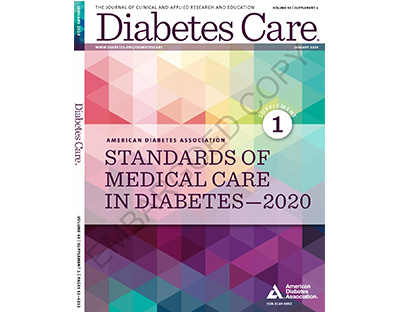
1. ADA publishes Clinical Practice Recommendations 2020

The 2020 Standards of Care from American Diabetes Association(ADA) constitutes many revisions in addition
to many minor changes that clarify recommendations or reflect new evidence. Some
of the relevant revisions to the standards of care are as follows:
Section 2. Classification and Diagnosis of Diabetes
A new section on “Pancreatic Diabetes or Diabetes in the Context of Disease of the Exocrine Pancreas” to describe this form of diabetes and its diverse set of etiologies was included. The “Gestational Diabetes Mellitus” (GDM) section was revised, and the two-step approach for screening and diagnosing GDM no longer includes National Diabetesz Data Group criteria.
Section 3. Prevention or Delay of Type 2 Diabetes
The section “Nutrition” was updated and a new recommendation (3.3) was added to recognize that a variety of eating patterns are acceptable for people with prediabetes. Also, more information was added on the risk reduction certain groups experienced with metformin use, based on 15-year follow-up data from the Diabetes Prevention Program Outcomes Study.
Section 4. Comprehensive Medical Evaluation and Assessment of Comorbidities
The autoimmune diseases recommendation (4.12) was modified, and a new recommendation was added (4.13) with autoimmune thyroid disease and celiac disease screening guidance differentiated, and more information on the prevalence of and screening for these diseases has been added. Because infection with hepatitis C virus is associated with a higher prevalence of type 2 diabetes, discussion was added regarding glucose metabolism and eradication of hepatitis C virus infection.
The section “Psychosocial/Emotional Disorders,” including anxiety disorders, depression, disordered eating behavior, and serious mental illness, was moved to Section 5 “Facilitating Behavior Change and Well-being to Improve Health Outcomes” in order to combine it with existing psychosocial guidance found in that section.
Section 6. Glycemic Targets
Based on the publication “Clinical Targets for Continuous Glucose Monitoring Data Interpretation: Recommendations From the International Consensus on Time in Range” (https://doi.org/10.2337/dci19-0028) published in June 2019, new recommendations (6.4 and 6.5) were added on use of the ambulatory glucose profile (AGP) report and time in range (TIR) for assessment of glycemic management. Discussions on the importance of reducing therapeutic inertia in the management of hyperglycemia and cardiovascular disease was included in the section “A1C and Cardiovascular Disease Outcomes.” New to “A1C and Cardiovascular Disease Outcomes” is the strategy to introduce sodium–glucose cotransporter 2 inhibitors or glucagon-like peptide 1 (GLP-1) receptor agonists in patients with cardiovascular disease meeting A1C goals for cardiovascular benefit.A new recommendation (6.11) on screening patients who are taking medication that can lead to hypoglycemia for hypoglycemia unawareness was introduced.Intranasal glucagon and glucagon solution for subcutaneous injection were included in the section “Hypoglycemia” due to their recent approval by the U.S. Food and Drug Administration (FDA).This section was modified to include a new discussion on the use of continuous glucose monitoring technology in hypoglycemia prevention.
Section 7. Diabetes Technology
This section was reorganized into three broad categories titled “Self-Monitoring of Blood Glucose,” “Continuous Glucose Monitors,” and “Insulin Delivery.” Within these revised sections, emphasis has been made on how there is no “one-size-fits-all” approach to technology use in people with diabetes.
Section 8. Obesity Management for the Treatment of Type 2 Diabetes
The body mass index (BMI) calculation recommendation (8.1) was modified to recommend annual BMI calculations rather than at every patient encounter.
Section 9. Pharmacologic Approaches to Glycemic Treatment
A discussion was added on access to analog insulins and how there are multiple approaches to insulin treatment, with the goal of keeping patients safe and avoiding diabetic ketoacidosis and significant hypo- or hyperglycemia.er.
New evidence and a recommendation (9.6) were added on early combination therapy for type 2 diabetes to extend the time to treatment failure based on findings from the VERIFY trial. FDA approval of oral semaglutide has been included in the discussion of combination therapies.
Section 10. Cardiovascular Disease and Risk Management
This section is endorsed for the second consecutive year by the American College of Cardiology. Blood pressure targets for pregnant patients with pre-existing hypertension have been changed in the interest of reducing the risk for accelerated maternal hypertension and minimizing fetal growth impairment.Recommendations for statin treatment (primary and secondary prevention, 10.19–10.28) have been revised to minimize ASCVD risk.
The cardiovascular outcomes trials of available antihyperglycemic medications completed after the issuance of FDA 2008 guidelines table (Table 10.3) has been divided into three tables by drug class on DPP-4 Inhibitors, on GLP-1 receptor agonists and on SGLT2 inhibitors.
Section 11. Microvascular Complications and Foot Care
The recommendation on screening for chronic kidney disease (11.1) has been modified to include twice-yearly screenings for certain patients. A treatment recommendation (11.3) was modified to provide more detail on use of SGLT2 inhibitors and GLP-1 receptor agonists in patients with type 2 diabetes and diabetic kidney disease.
Screening for diabetic retinopathy recommendations (11.16 and 11.17) and supportive text were revised to include consideration of retinal photograph with remote reading or use of a validated assessment tool as a way to improve screening access.
Section 13. Children and Adolescents
To provide more detail for individualizing targets, new A1C goal recommendations (13.21–13.24) were added to the section “Glycemic Control.”In the section “Management of Cardiovascular Risk Factors,” the recommendations for screening and treatment of hypertension (13.31–13.35) have been revised and include new criteria for elevated blood pressure. The dyslipidemia testing recommendation (13.36) was also modified, and more evidence was added to the dyslipidemia screening section. The retinopathy screening recommendation for type 1 diabetes (13.46) has been revised based on new evidence supporting a lower frequency of eye examinations than previously recommended. A new recommendation (13.67) was added to the section “Pharmacologic Management” for type 2 diabetes due to new evidence and FDA approval of liraglutide in children 10 years of age or older. A new recommendation (13.76) on pharmacologic treatment of hypertension in type 2 diabetes was also added.
Section 14. Management of Diabetes in Pregnancy
Recommendations (14.9–14.12) on use of continuous glucose monitors and measuring glycemia in pregnancy were added to the section “Glycemic Targets in Pregnancy” to provide more informati on on their utility. Further discussion has been added regarding when insulin may not be an option for some women with GDM, and how oral agents may play a role in treatment in certain circumstances.
Section 15. Diabetes Care in the Hospital
Discussion of new studies supporting the use of closed-loop insulin delivery with linked pump/sensor devices to control blood glucose was added to the type 1 diabetes section “Transitioning Intravenous to Subcutaneous Insulin”.
For enquiries info@jothydev.net.
Please visit: jothydev.net | research.jothydev.com | diabscreenkerala.net | jothydev.com/newsletter
